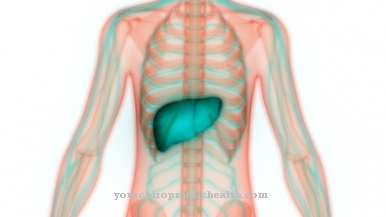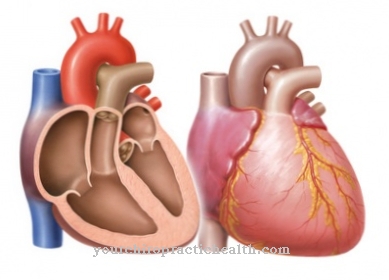Of the Reflex arc is the shortest neural connection between receptors and target organs and triggers a body reflex. The input is via the afferent limb of the arch, while the output takes place via the efferent limb. Changes in the reflex arcs can be diagnosed by electrophysiological examination.
What is the reflex arc?

The reflex arc is the sequence of neuronal processes that trigger a body reflex. As a rule, the term describes the shortest connection between certain receptors and effectors, which runs via the neurons of a certain excitation circuit.
Each reflex arc encompasses the neural influx of information from the central nervous system. This influx is also called the afferent thigh and is used to input information. At least one central neuron forms the basis of the reflex arc.
In addition, the reflex arc always contains an efferent structure in which the information from the central nervous system is directed to the periphery. This structure is also known as the efferent leg of the reflex arc. The last part of the reflex arc is the effector, i.e. the organ that carries out the reflex. The effector is thus the end point of the targeted, neural process.
In the simplest and fastest form, the efferent and afferent legs are interconnected via a single synapse in the anterior horn of the spinal cord. In this case we are talking about monosynaptic reflexes. This is to be distinguished from polysynaptic reflex arcs, in which several central neurons are connected in series.
Function & task
If people stumble, they often catch themselves before they fall, for example by changing the position of their legs. If he chokes, he won't choke by causing a cough reflex. If an object flies towards him, he automatically pulls his arms in front of his face and when something approaches his eye, his lid involuntarily closes. Reflexes like these are rapid and involuntary movements in response to a particular stimulus.
Most reflexes are supposed to protect the organism from damage, for example the eyelid closing reflex. All reflexes consist of an interaction of the sense organs, nerves and muscles. In this way, responses to certain stimuli can be delivered.
While some reflexes are innate, others are acquired based on experience. The reflex arc plays a major role for all of them, because only this system ensures the prompt reflex response to a certain stimulus. Protective reflexes in particular are dependent on this quick response, as they would otherwise no longer serve a purpose.
In addition to a receptor, each reflex arc contains an afferent limb for the input of information, central neurons, an efferent limb for the reflex output and an effector that carries out the output information. Afferent thighs consist of afferent nerve fibers of the receptors, such as those represented by the class I neurons on the spindles of the muscles. Axons or motor neurons form the efferent limb. The postganglionic fibers are also partly involved in the efferent thigh. Effectors can either be organs such as the heart or specific muscles and glands.
In all monosynaptic reflexes, the afferent thigh arises from the sense organs and their receptors. Muscle spindle can also be involved as sensitive receptors on the afferent thigh. The afferent impulse is always conducted into the spinal cord. If transmission to the brain were required, the reflex response would take too much time.
The projection into the spinal cord takes place via the sensitive nerve cells. The pyramidal tracts of the spinal cord are involved in monosynaptic reflexes with inhibiting or stimulating influences. Just as the afferent limb opens into the spinal canal, the efferent limb of the reflex arc opens into muscles, organs or glands. The efferent impulses are transmitted from the spinal cord to motor nerve pathways that are located in the motor anterior horn. Motoaxones thus direct the efferent output to the target organ. These axons belong to the Aα fibers and have a correspondingly high conduction velocity.
In the case of self-reflexes, the receptor and the effector are in the same organ. In the case of external reflexes, on the other hand, they are in different organs.
Illnesses & ailments
The reflex examination is one of the standard neurological examinations. This reflex test is primarily used to detect pathological reflexes that can arise in the context of various diseases. The Babinski reflex, the Chaddock reflex and the Gordon reflex, but also the Mendel-Bechterew reflex, the Oppenheim reflex and the Rossolimo reflex are counted as pathological reflexes.
Pathological reflexes belong to the so-called pyramidal tract signs and thus give an indication of damage to the pyramidal tracts in the spinal cord. With such a damage, the course of the reflex arc is disturbed, since all monosynaptic reflexes run through this center.
Pyramidal orbital signs can arise in the context of various diseases. In the autoimmune disease multiple sclerosis (MS), for example, inflammation can cause lesions in the pyramidal tracts and thus trigger signs of the pyramidal tract. In MS, the presence of pyramidal signs shortly after the onset of the disease is considered a bad sign and thus has a negative impact on the prognosis.
As a rule, pathological reflexes are associated with central paralysis, for example with hemiplegia, the origin of which lies in the central nervous system. An electrophysiological examination reveals central and peripheral reflex arc patterns. Pathological changes in the reflex arcs can also be diagnosed in this way. Such changes can limit the localization of brain lesions and occur, for example, in the context of a stroke.


.jpg)
























